Flower Glossary is reader-supported. When you buy through links on our site, we may earn an affiliate commission.
Bonsai trees have been popular with both indoor and outdoor gardeners for centuries. Their miniature size gives them a magical feeling, and they wouldn’t be out of place in a fairytale scene.
However, despite their enchanting nature, some people are put off the idea of growing bonsai trees as they think they are incredibly difficult to maintain. But, this isn’t necessarily true!
To prove this, we’ve compiled a list of 64 popular types of bonsai trees that are low maintenance and easy to grow. We’ve also broken them down into separate categories to make it even easier to find the perfect type of bonsai tree for the growing conditions you can offer.
Table of Contents
Juniper Bonsai Trees
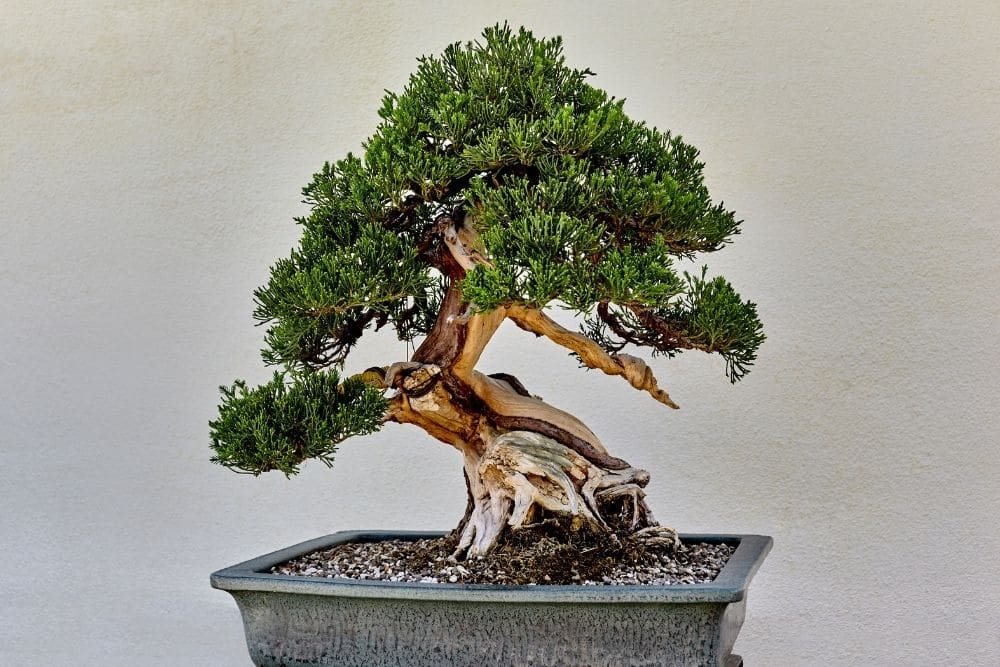
This is the simplest type of bonsai and it’s incredibly easy to maintain, making it a perfect choice for anybody new to the art. Juniper Bonsai Trees are really forgiving as well and nothing bad will happen if you forget to water them for a brief period of time.
When it comes to pruning, they continue to be a novice’s dream. This is because branches are extremely flexible which makes them easy to shape into whatever form you like.
Now, let’s take a look at the different types of bonsai trees within the juniper category.
Green Mound Juniper Bonsai Tree
Unless stated otherwise on the plant’s label, the juniper bonsai trees you’ll most commonly find for sale are Green Mound Juniper Bonsai Trees. Like all juniper bonsais, these are really easy to grow and their foliage is easy to maintain.
Green Mound Juniper Bonsai Trees are also quite happy living in different climates, although they do need some protection from direct sunlight.
Needle Juniper Bonsai Tree
Also known as the Himalayan Juniper of Juniperus Squamata, Needle Juniper Bonsai Trees are also easy to grow. They have flexible branches that are easy to prune and shape, and they are also happy living in a variety of climates.
Indoor Bonsai Trees
If you live in an apartment, or if your garden is simply full of outdoor plants already, you’re best off choosing a bonsai tree from the ‘indoor’ category. These are also much easier to maintain as they don’t have to face the elements and they are ideal for new bonsai tree artists.
Acai Bonsai Tree
Acai Bonsai Trees thrive in sunlight, so if you’ve got a South-facing windowsill that’s looking a little empty this could be the perfect choice. They do need a little water every day, but only a small amount each time. Other than that, they are low maintenance and easy to grow!
Bonsai Money Tree
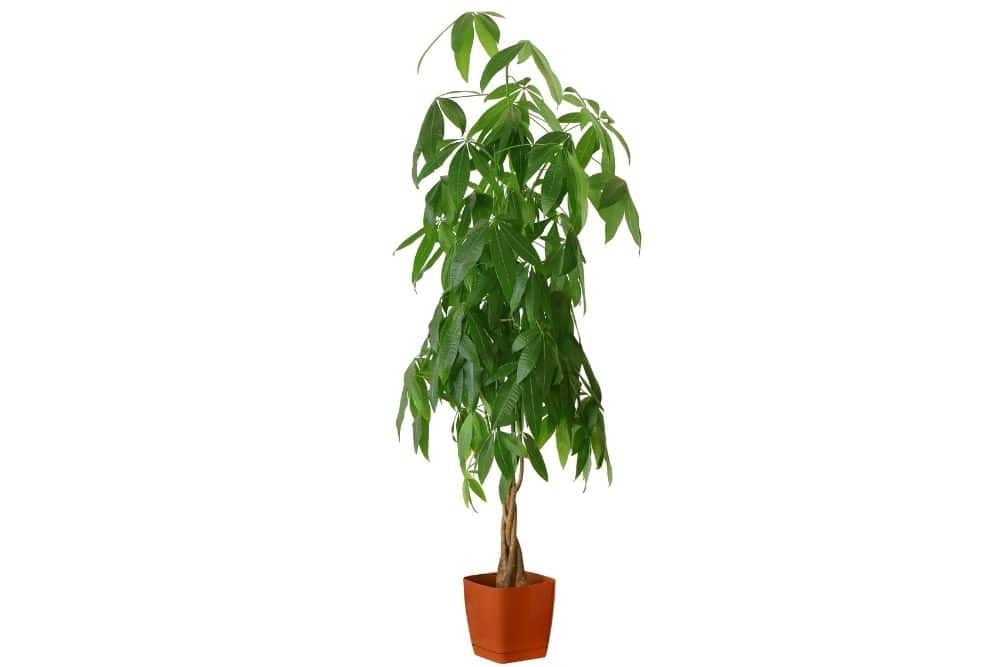
Also known as Pachira Aquatica, the Bonsai Money Tree has a legend behind it that adds to its charm.
The story goes that when a poor man prayed for luck, he was gifted with a Bonsai Money Tree. He took it everywhere he went with him and, once he started caring for it through the art of bonsai, he was able to reproduce and sell them. This resulted in great riches, hence the name “Money Tree”.
Just like most indoor bonsai trees, these are easy to care for and they require very little maintenance. They are also a favorite among people practicing Feng Shui as they are believed to bring luck into your home.
Baobab Bonsai Tree
Baobab Bonsai Trees are quite rare and, as such, they tend to come with a fairly hefty price tag! They are undeniably stunning though and if you do manage to find one, you’ll be blown away by their magical appearance.
One thing you need to know about Baobab Bonsais, however, is that they are incredibly slow-growing. This does mean that they are pretty low-maintenance, but if you’d like to see your bonsai grow a little faster it would be best to go for another variety.
Boxwood Bonsai Tree
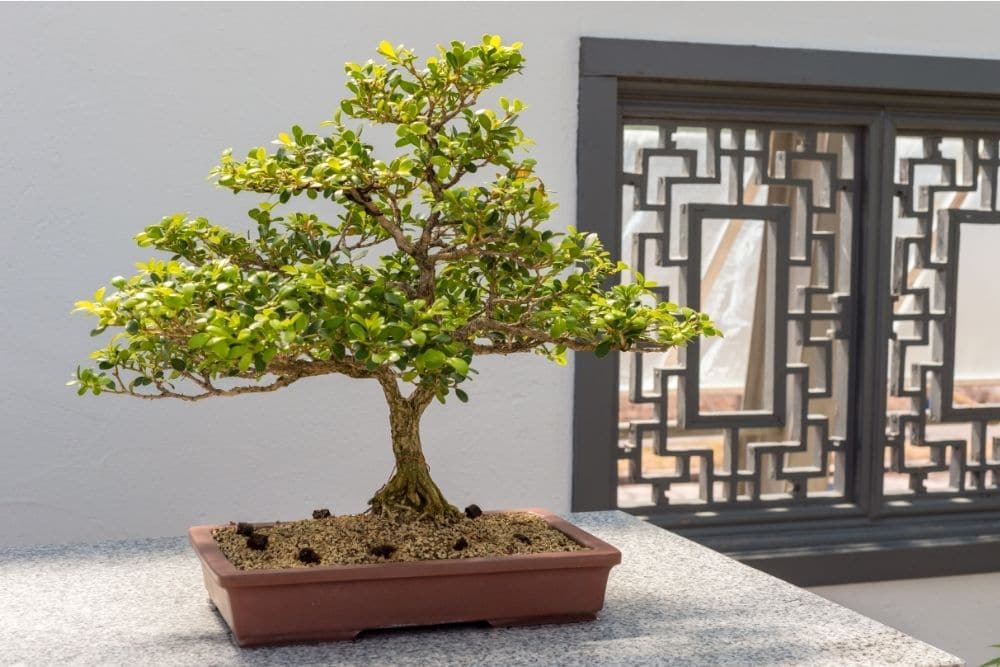
Boxwood (or Buxus) is most commonly used as a hedging plant, but it can also be grown as a bonsai tree. It’s really fast-growing, so it’s ideal if you’d like to learn the art of bonsai quickly. It’s also perfect for anybody new to bonsai as it’ll allow you to make some mistakes without causing too much irreversible damage.
Boxwood Bonsai Trees need protection from cold weather during winter and they need to be consistently watered during the summer months. Aside from this, they are pretty easy to care for.
Brazilian Rain Bonsai Tree
If you’re looking for architectural interest, the Brazilian Rain Bonsai Tree is a fine choice. It has delicate, pointed branches that are adorned with bright green leaves. During the day, these leaves lay out flat, soaking up the sun’s rays. But, at night, they fold themselves up for protection!
Brazilian Rain Bonsai Trees need to be kept consistently warm. So, while you can move out onto a balcony during the summer, they need to be bought back indoors at night time when the temperature drops.
Buddha’s Ear Bonsai Tree
This is one of the easiest types of bonsai trees you can grow. All you have to do is keep them indoors in a sunny position and keep their soil moist. In return, you’ll be rewarded with bright green, architectural leaves.
Buddhist Pine Bonsai Tree
This is another super low-maintenance bonsai tree that thrives in indoor conditions. Place in a well-lit spot and water the soil whenever it feels dry. That’s all you have to do to care for this magnificent little tree!
Cactus Combo Bonsai Tree
If you really don’t have time to water your plants, a Cactus Combo Bonsai Tree is perfect. Granted, they don’t have quite the same fairytale-esque appearance as some other bonsai trees, but they are ideal for busy people who are away from home a lot.
Since they are cacti, these trees don’t need much water at all. Once a month during the summer is more than enough to keep them happy and healthy all year round.
Cedar Bonsai Tree
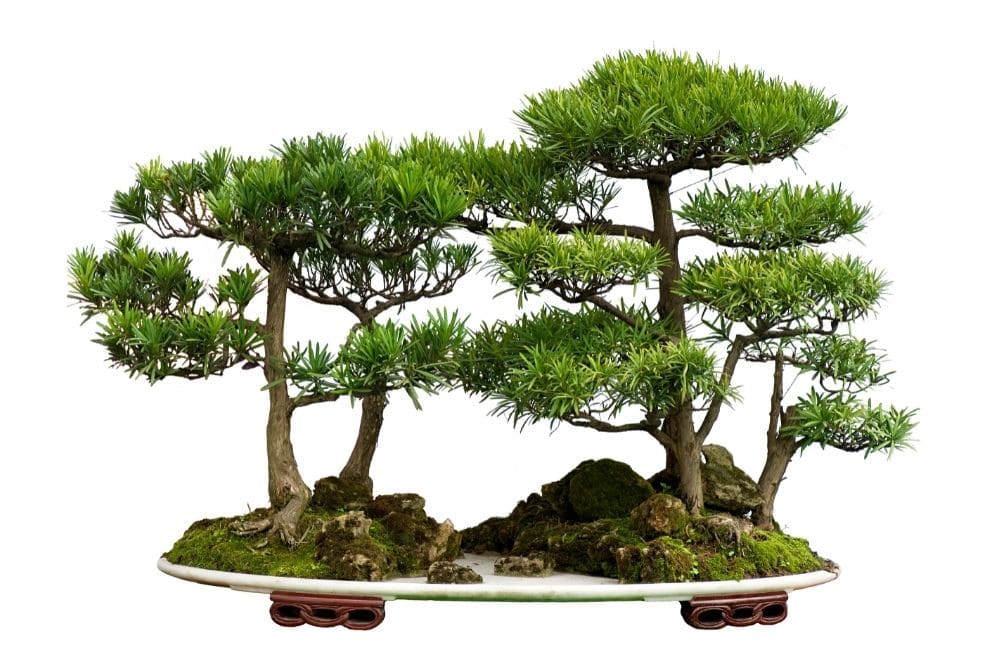
These are a good choice if you’d like a bonsai tree that can grow quite tall. It will still stay miniature, of course, but it’ll bring some extra height to a collection of bonsais grouped together.
Also known as Cedrus, Cedar Bonsai Trees need to be watered regularly and placed in a sunny position indoors.
Desert Rose Bonsai Tree
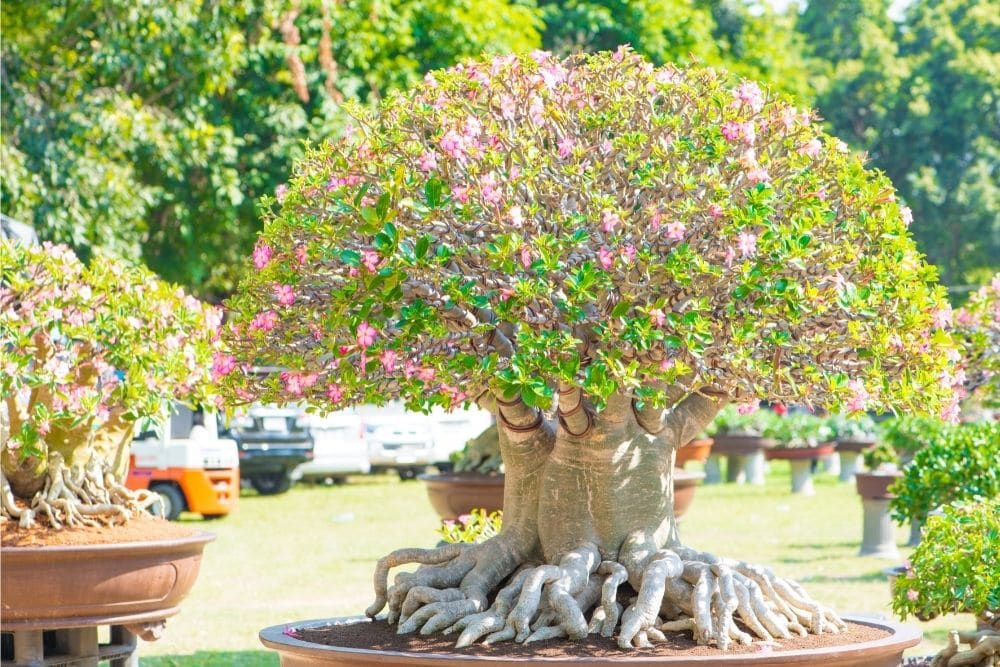
Although this is technically a plant and not a tree, the Desert Rose is often grown as a bonsai tree as it does really well in small pots. It can be grown all year round indoors and it can also be placed outdoors during the summer months.
One of the standout characteristics of the Desert Rose Bonsai Tree is the abundance of pink flowers that grow from every branch in the spring.
Ficus Bonsai Tree
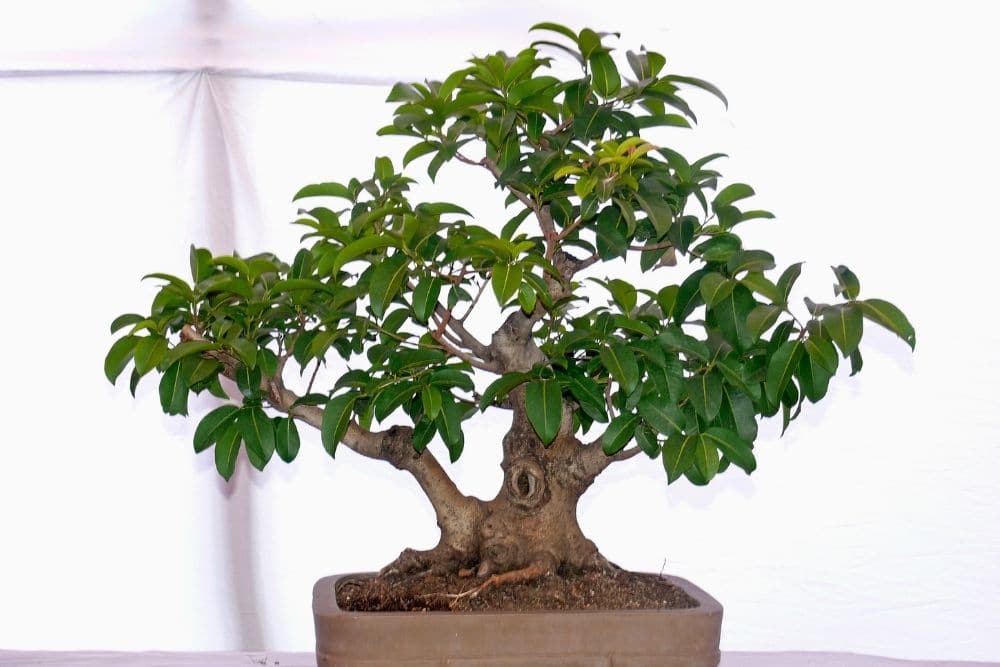
The Ficus Bonsai Tree is most popular for its unique S-shaped trunk. It’s also really easy to care for which, when combined with its aesthetically pleasing appearance, makes it a great choice for beginners.
Given plenty of light, a Ficus Bonsai Tree will grow quite happily indoors. You can also move it to a sunny patio or balcony during the summer months.
Jade Bonsai Tree
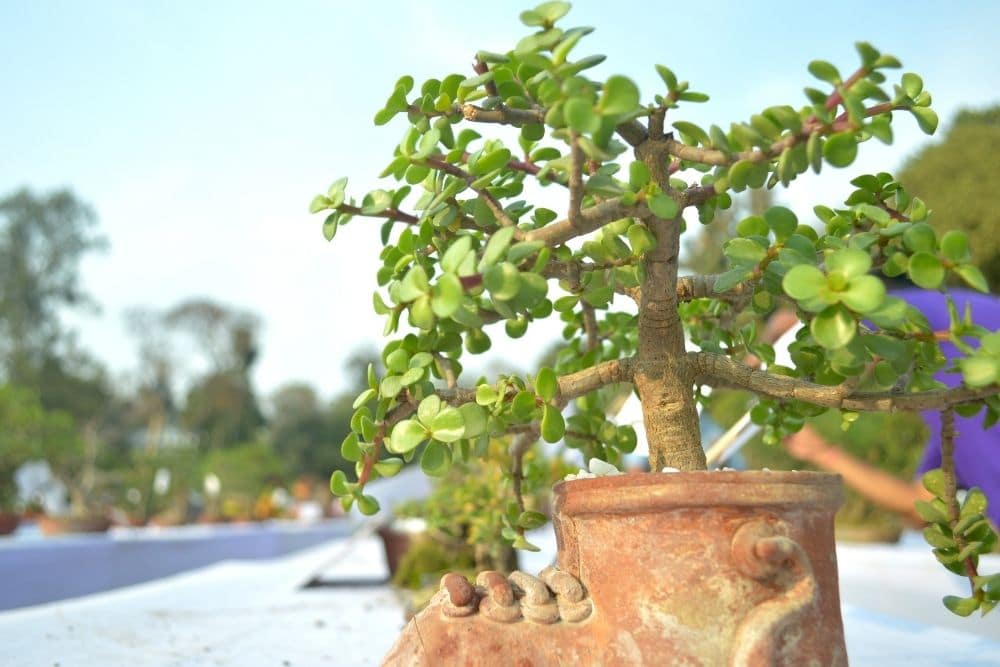
Although relatively easy to care for, the Jade Bonsai Tree needs almost constant exposure to full sun and warm temperatures. This is why it’s ideal for growing indoors.
Their thin, flexible branches can be shaped quite easily and, if you’re lucky, you may be treated to a display of flowers in the spring.
Hawaiin Umbrella Bonsai Tree
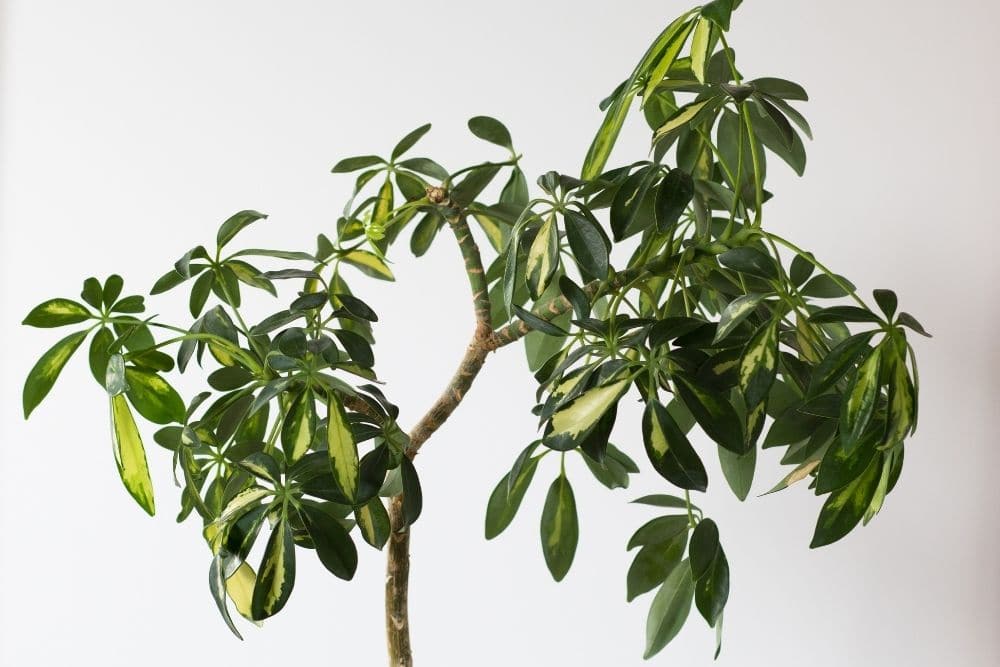
As you have guessed from its name, the Hawaiin Umbrella Bonsai Tree is native to Hawaii. For this reason, it does really well when grown indoors where temperatures are warmer all year round.
Also known as Schefflera arboricola, this bonsai requires very little maintenance. Just give it plenty of sunlight, water it when the soil feels dry, and it will be a happy little tree!
Beech & Hornbeam Bonsai
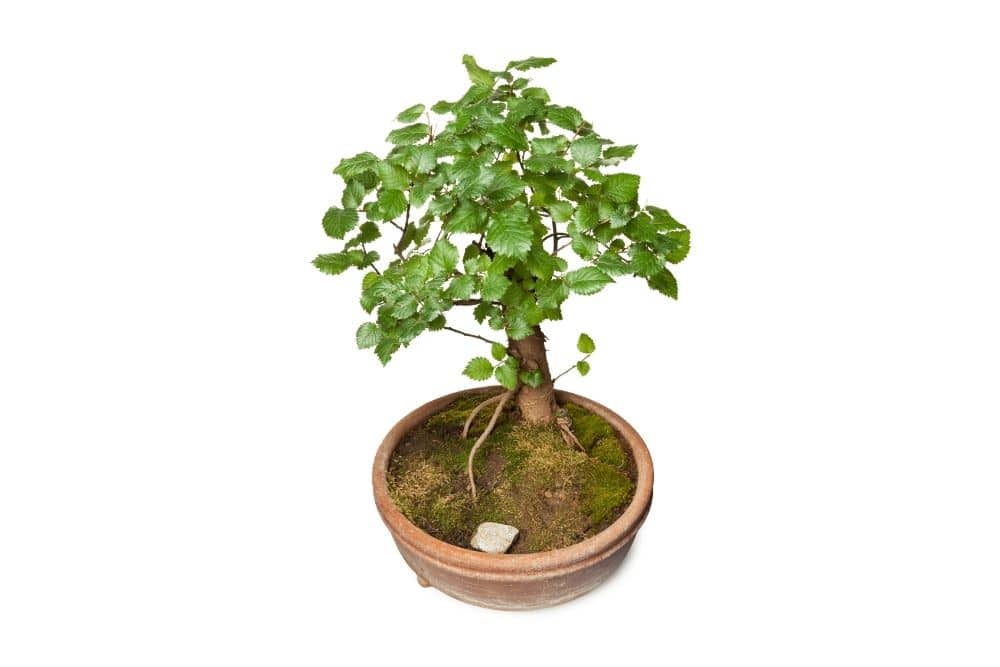
While these are technically two different types of trees, we’ve combined them into one as they have such similar care requirements. They are best grown indoors as they cannot bear direct sunlight, but they’ll be happy living in indirect sunlight indoors.
They should also be protected from harsh weather conditions, which is another reason why they do so well when grown indoors.
Jacaranda Bonsai Tree
This type of tree is native to Central and South America and, as such, it adores a sunny spot along a windowsill. Try not to group them too close to each other or mix them in with other bonsais though, as they need a good amount of airflow between their branches.
They aren’t the most low-maintenance bonsai tree, and you’ll need to trim them regularly to help them grow. But, if you have the time and patience, you’ll have a beautiful specimen that displays purple flowers in the spring.
Norfolk Island Pine Bonsai Tree
Norfolk Island Pine Bonsai Trees (Araucaria heterophylla) is really easy to grow and it only needs to be pruned a couple of times a year. It does, however, have some particular light requirements and it needs to be moved around every couple of weeks so that it can take in sunlight from all angles.
Weeping Willow Bonsai Tree
Although native to China, the Weeping Willow can be found growing right across the globe. This is one of the most interesting trees you can add to your bonsai collection and their long, weeping branches give it loads of character.
However, it’s this growth habit that can make it quite difficult to prune, so you’ll need to be fairly confident in your bonsai-styling skills to take proper care of it.
Outdoor Bonsai Trees
If you are lucky enough to have an outdoor space, adding a bonsai tree to your garden is a guaranteed way of building structure and interest. Each of the bonsais we’ve listed below are ideal for growing outdoors.
Bamboo Bonsai Trees
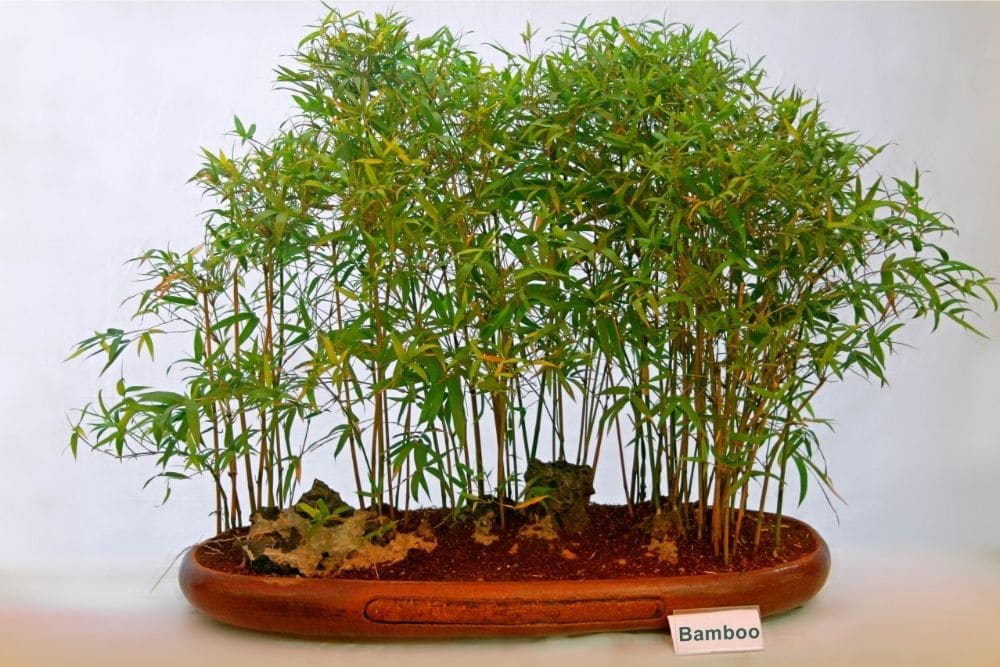
Bamboo Bonsai Trees are quite rare but they certainly bring some character to your outdoor space. They are also quite difficult to prune as the nature of bamboo is to grow straight upwards and it doesn’t branch out in the way a tree would.
However, it’s not impossible, and if you’re well-practiced in the art of bonsai, a Bamboo Bonsai Tree could be the next project you’ve been looking for!
Birch Bonsai Tree
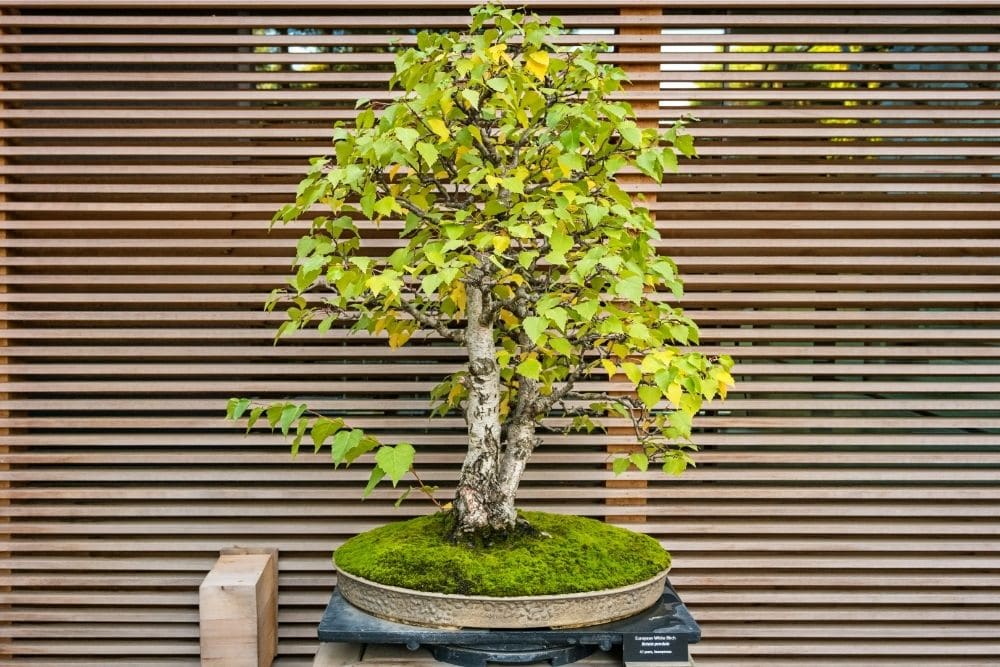
If you live in a sunny, warm climate then a Birch Bonsai Tree will absolutely thrive in your garden. They do need quite a lot of water throughout the growing season but, if you can keep on top of this, you’ll have a really unique bonsai tree that would look great sitting on top of a patio table.
Buttonwood Bonsai Tree
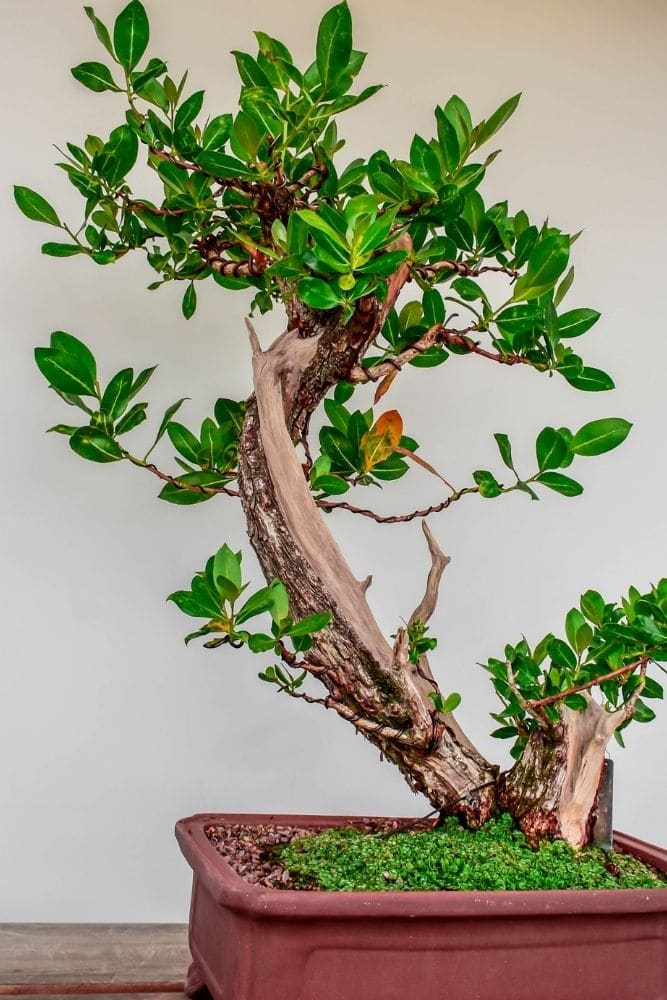
Chinese Elm Bonsai Tree
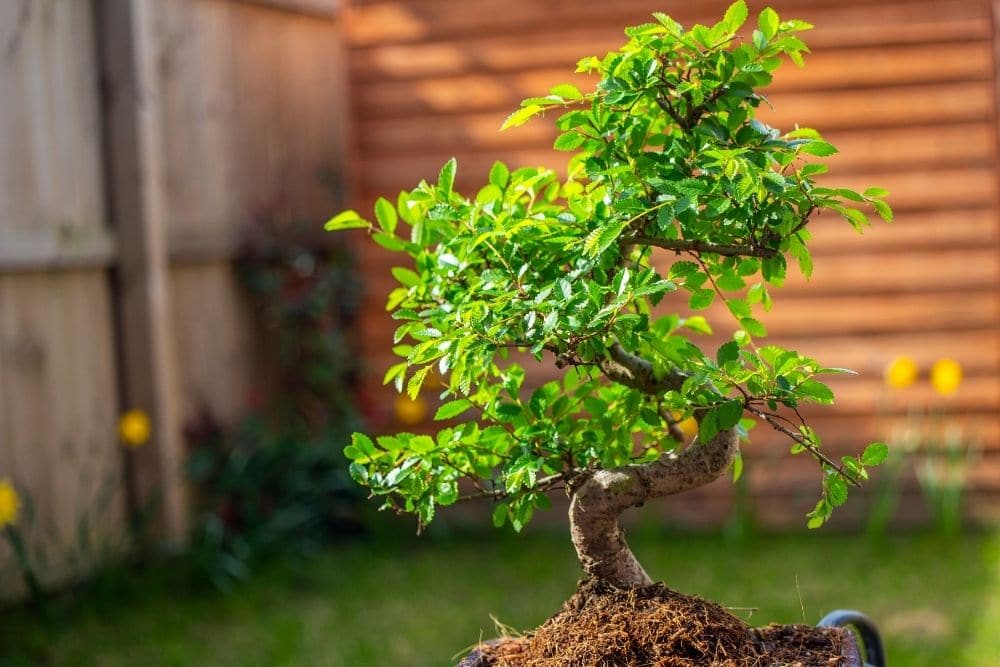
Chinese Elm Bonsai Trees have a tendency to soak up loads of water so this is something you’ll need to keep on top if you choose one of these for your garden. They absolutely thrive in warm, sunny weather, so a south-facing position would be ideal.
Ginkgo Bonsai Tree
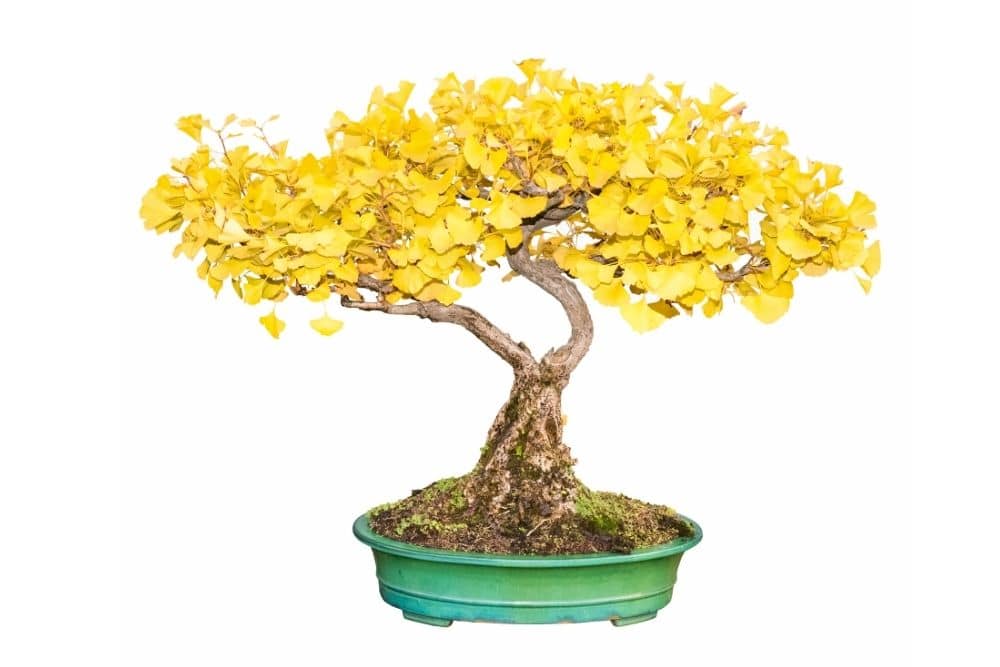
One of the most interesting things about the Gingko Bonsai Tree is that its leaves change color with the seasons. This gives it year-round appeal and allows it to blend in harmoniously with other deciduous trees in your garden. To keep it as happy as possible, all you have to do is make sure the soil is consistently moist.
Hinoki Cypress Bonsai Tree
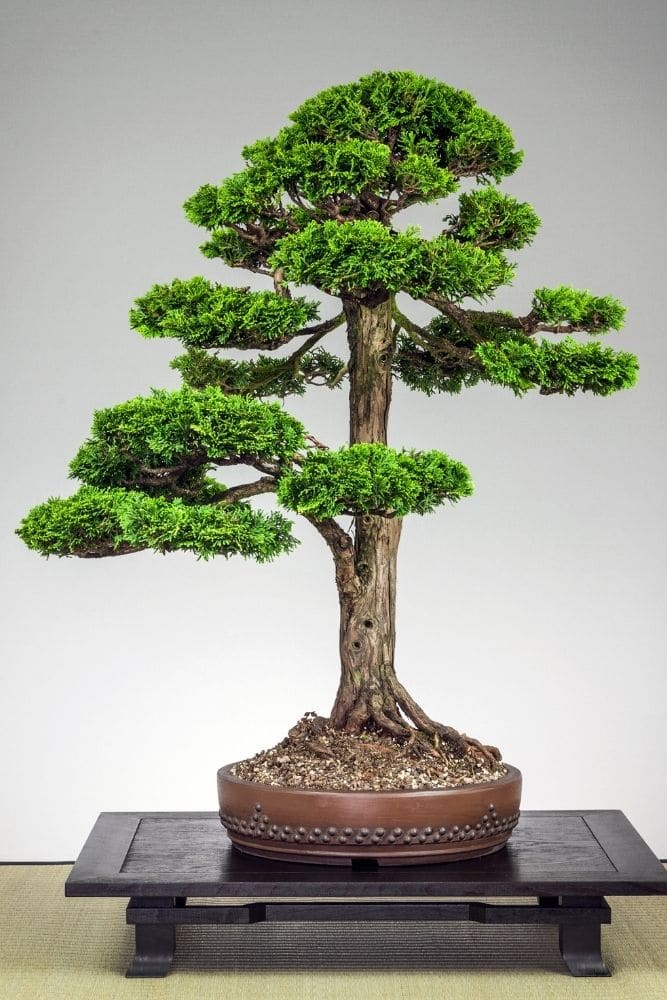
Bald Cypress Bonsai Tree
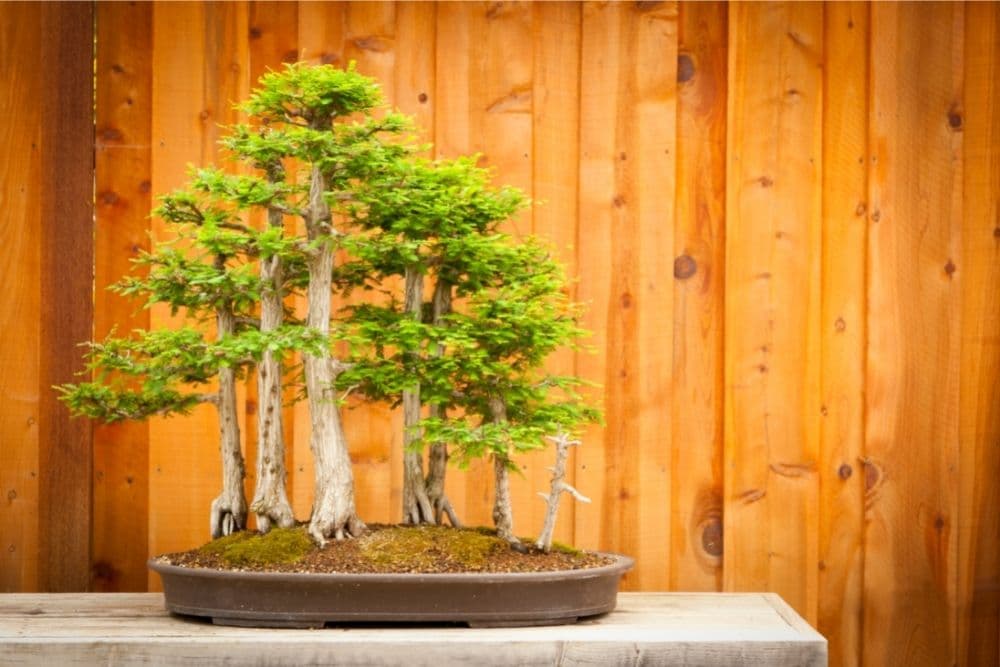
Also known as Taxodium distichum, the Bald Cypress is native to southern areas of the United States, Guatemala, and Mexico. This means that, unsurprisingly, it thrives in full sun. Maintenance is a simple task of keeping it well-watered during hot weather.
Japanese Black Pine Bonsai Tree
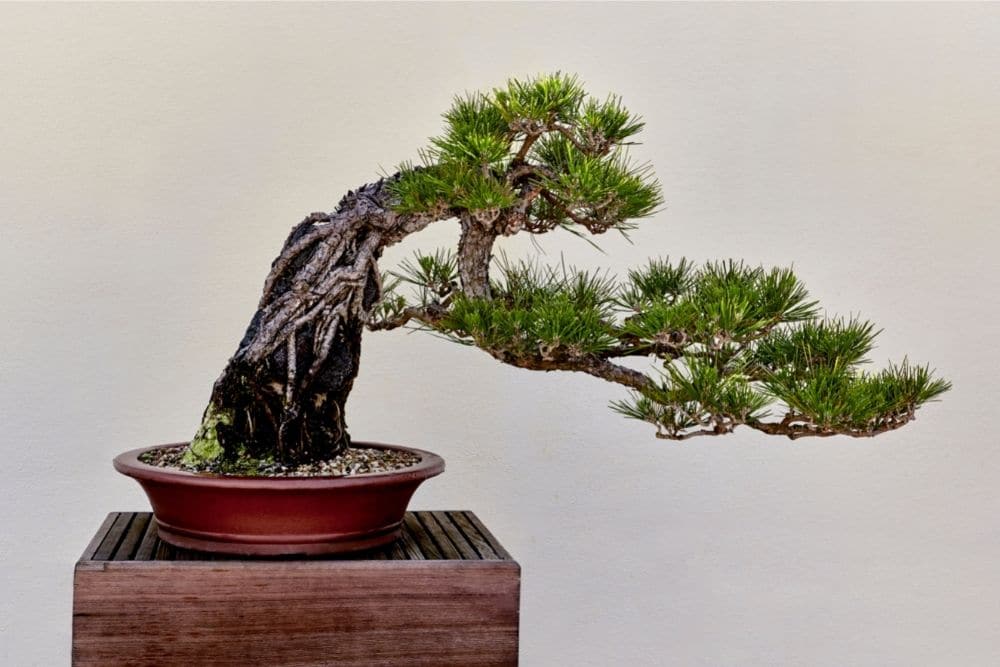
This is one of the hardiest bonsai trees you’ll ever find. Since Japanese Black Pines are capable of surviving harsh climates, you can get away with forgetting to water for a week or two without causing any damage. It’s also quite happy in full sun, partial shade, or full shade.
Japanese Maple Bonsai Tree
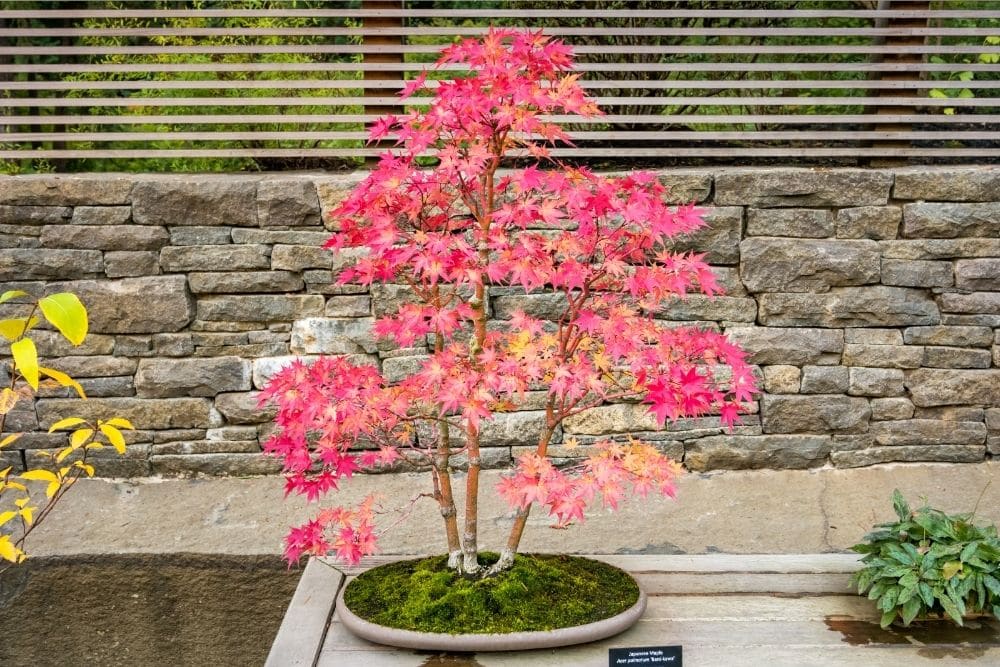
Often referred to as Acer Palmatum, the Japanese Maple is a truly stunning tree. It’s also quite happy to grow in shady conditions, so it’s perfect for an outdoor space that doesn’t get much sunlight throughout the day. The only thing you need to be wary of is overwatering, as this can affect its growth.
Larch Bonsai Tree
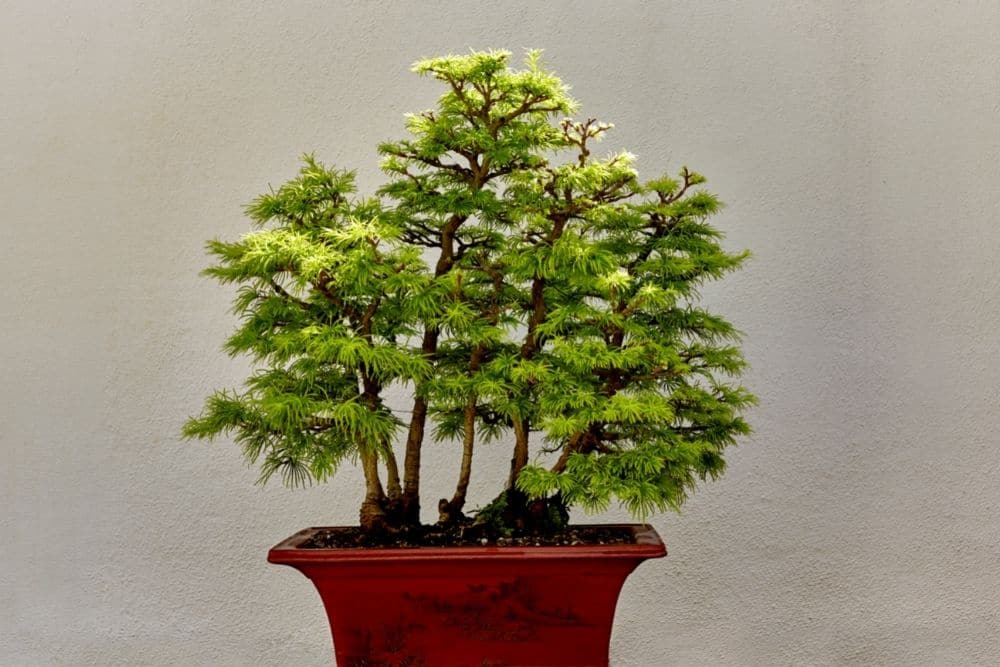
The Larch Tree, or Larix, is one the most commonly used trees in the art of bonsai. It’s really hardy and is happy being placed outside all year round, regardless of weather conditions or temperature fluctuations. The only thing you need to do is make sure you keep the soil consistently moist.
Liquidambar Bonsai Tree
This is another excellent choice if you’re looking for year-round interest, as the Liquidambar Bonsai Tree’s leaves will change color throughout the seasons. It’s also an incredibly low-maintenance tree, so it’s ideal for a beginner.
Oak Bonsai Tree
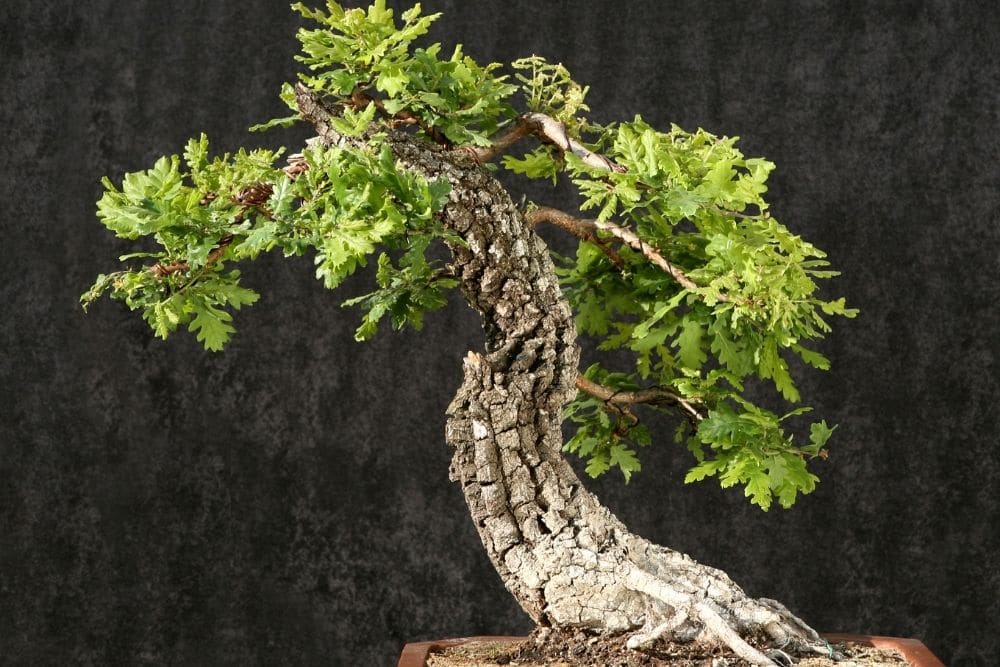
There is something truly magical about seeing an Oak Tree grown as a bonsai. They are also much easier to grow than you might think, and they are extremely resistant to differences in climate. They do prefer a sunny position and you’ll need to water regularly throughout the summer.
However, for the rest of the year, they are more than capable of taking care of themselves.
Premna Bonsai Tree
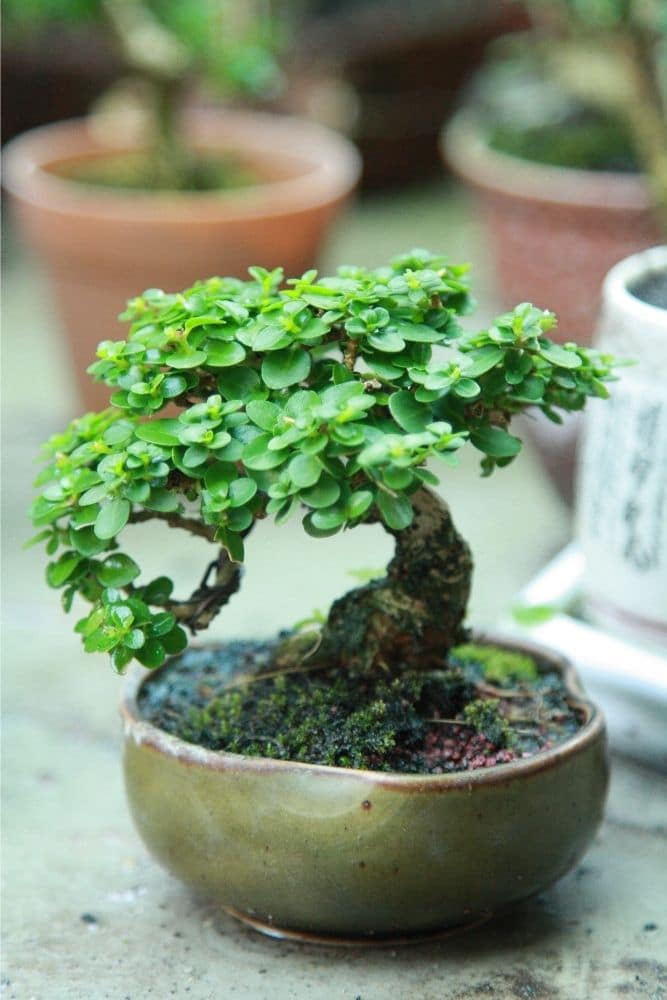
Redwood Bonsai Tree
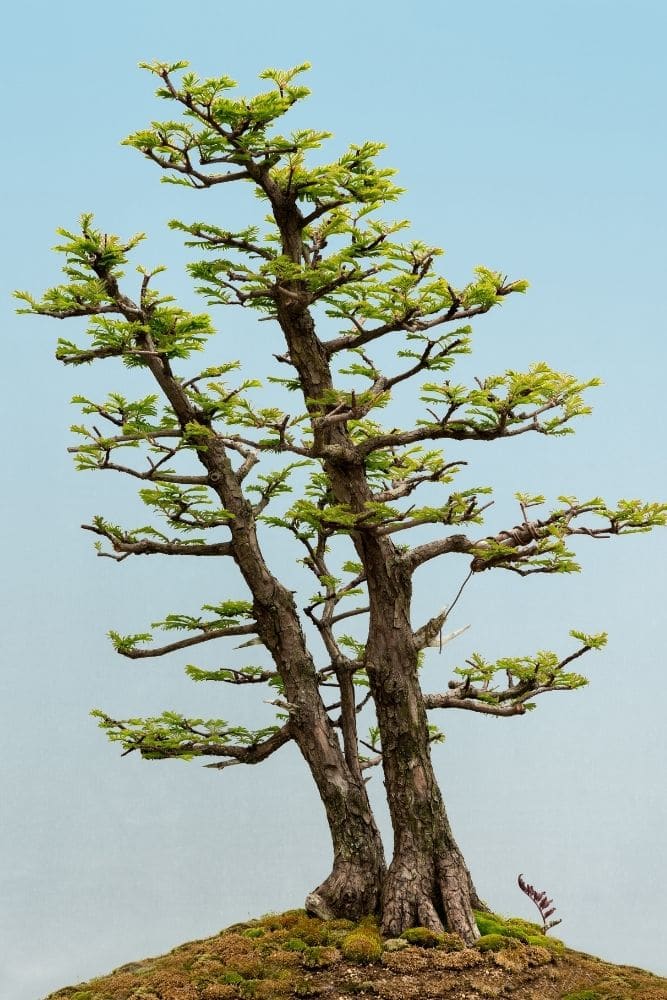
Spruce Bonsai Tree
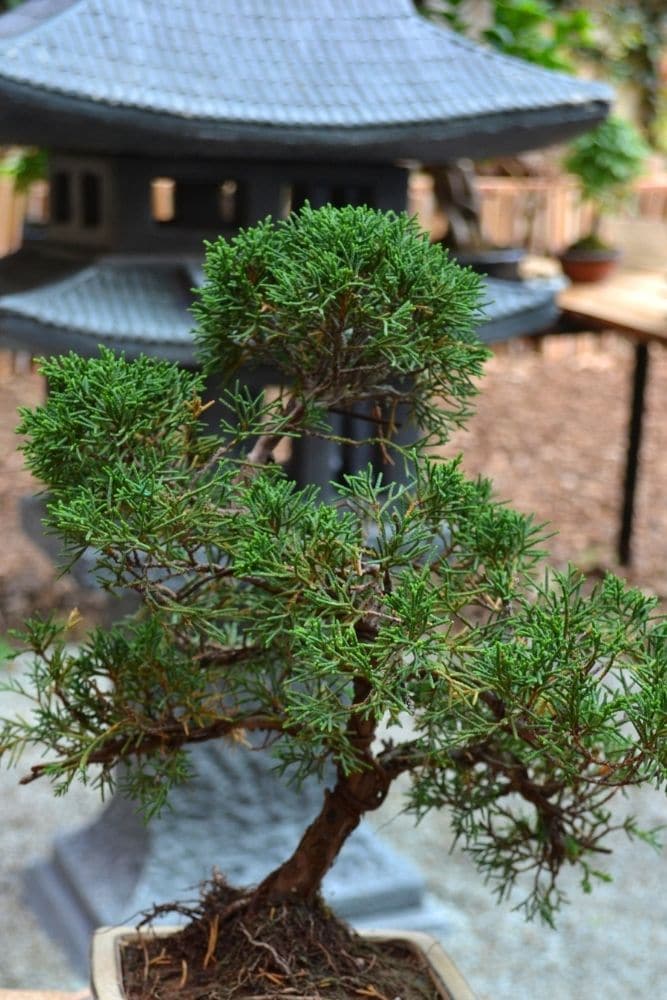
Trident Bonsai Tree
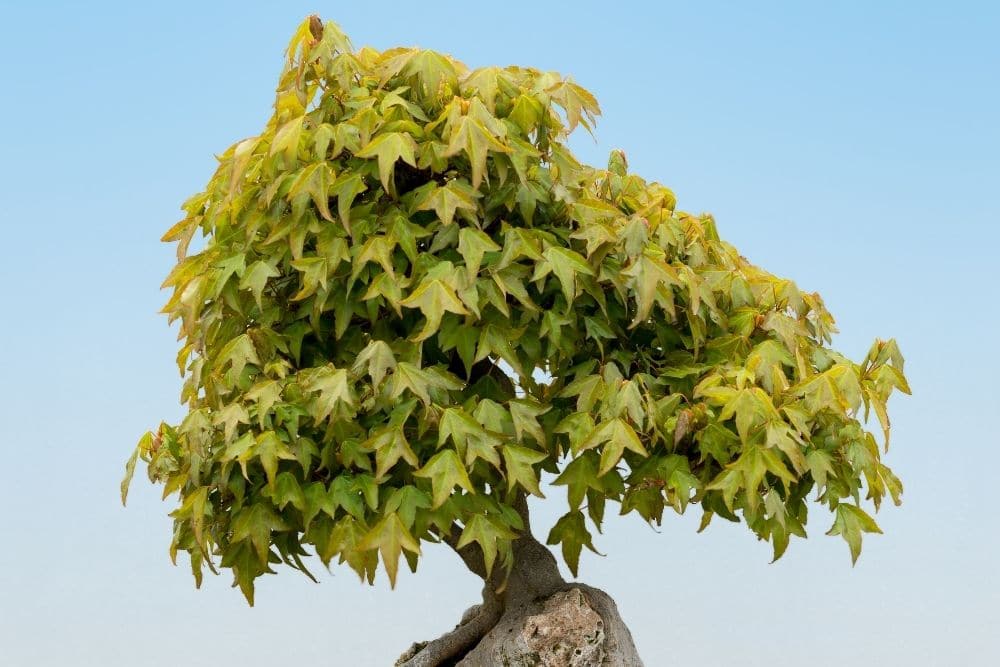
This is another form of Acer, but it’s not as popular as other Japanese Maples. The reason for this is because the Trident Bonsai Tree needs almost constant maintenance! They don’t do well when placed indoors, but they need to be protected from sunlight when grown outdoors.
This isn’t the best choice of bonsai for a beginner but, if you have experience and patience, it’s a great addition to your bonsai collection.
Fruiting and Flowering Bonsai Trees
One thing that many people don’t realize is that there are loads of fruiting and flowering trees and shrubs that can be shaped using the art of bonsai! It’s also much easier than you might think, and there are some fantastic choices for new and experienced bonsai gardeners alike.
Apple Bonsai Tree
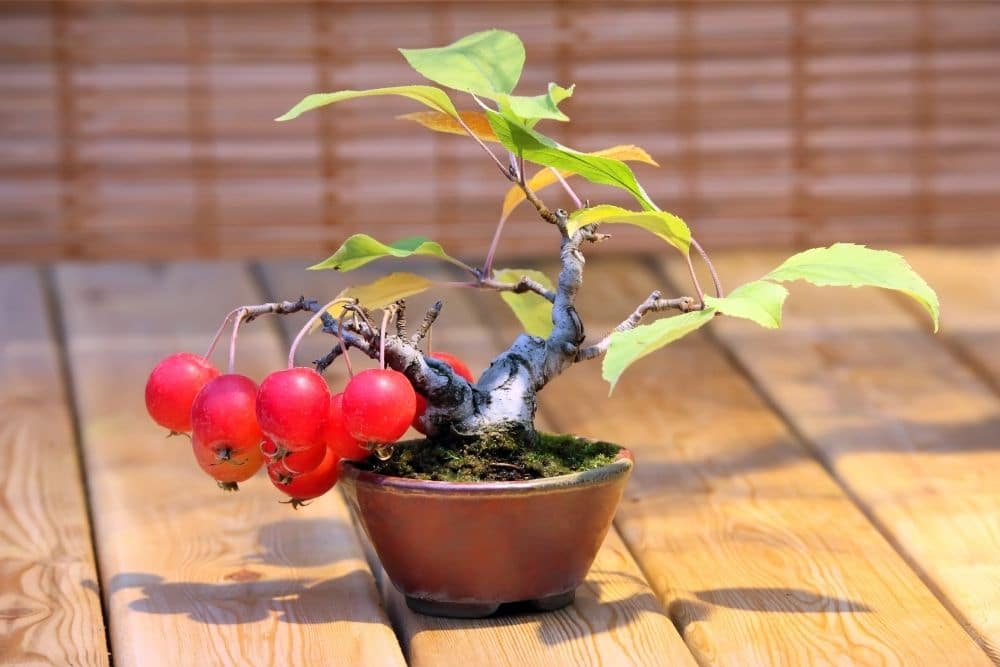
These are a little higher-maintenance than some other bonsai, but the display of apple blossom they put on in the spring is more than worth the effort! Water daily, feed with fertilizer throughout the growing season and make sure they are in as much sunlight as possible throughout the day.
Azalea Bonsai Tree
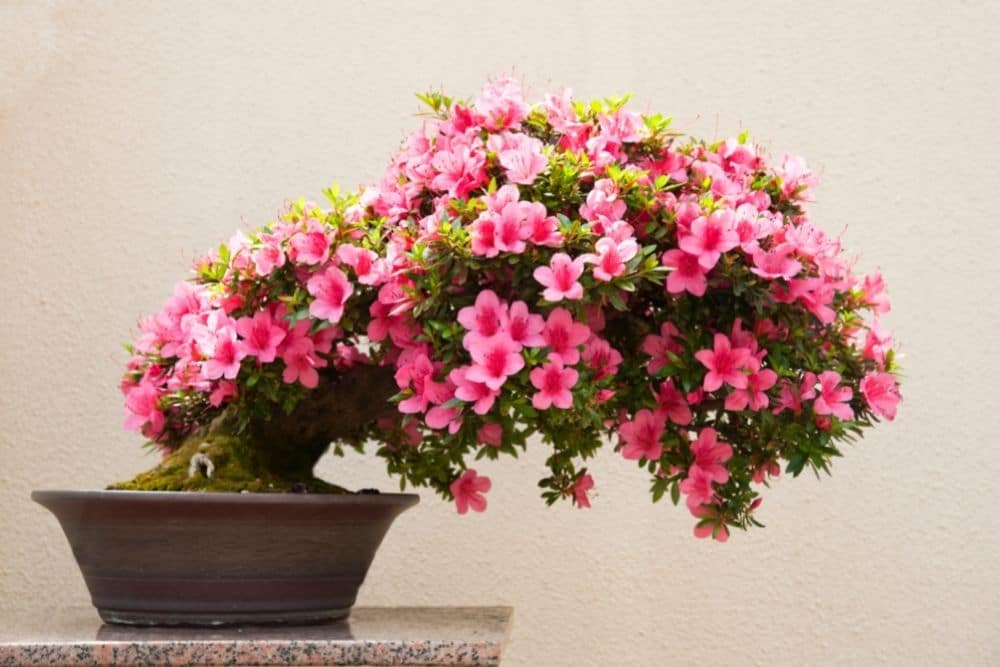
If you’d like to attract more pollinating insects to your garden, an Azalea Bonsai Tree will help you do just that! Beautiful flowers cover every inch of it during the spring which bees and butterflies will flock to. It will be happy living outdoors, but it does need some protection against extremely hot temperatures and direct sunlight.
Bahama Berry Bonsai Tree
The Bahama Berry Bonsai Tree is a great choice if you’re looking for that aged-bark effect straight away. This is because it has a unique, interesting appearance and even new growth looks like it’s been battered by the elements for years.
It’s easy to grow as well and all you need to do is make sure you place it in full sun throughout the day.
Black Olive Bonsai Tree
Don’t be fooled by this tree’s name. Even though they do produce a type of fruit that looks like an olive, these are not edible and, in fact, aren’t even olives at all! The branches of the Black Olive Bonsai Tree are really unique and they are covered with tiny spines.
They also tolerate extreme heat really well, so they are ideal for areas with really hot summers.
Bird Plum Bonsai Tree
The complete opposite of the Black Olive, the Bird Plum Bonsai Tree thrives best when placed in the shade. They do need watering frequently though, as they can die quite easily if their soil gets too dry.
Bougainvillea Bonsai Tree
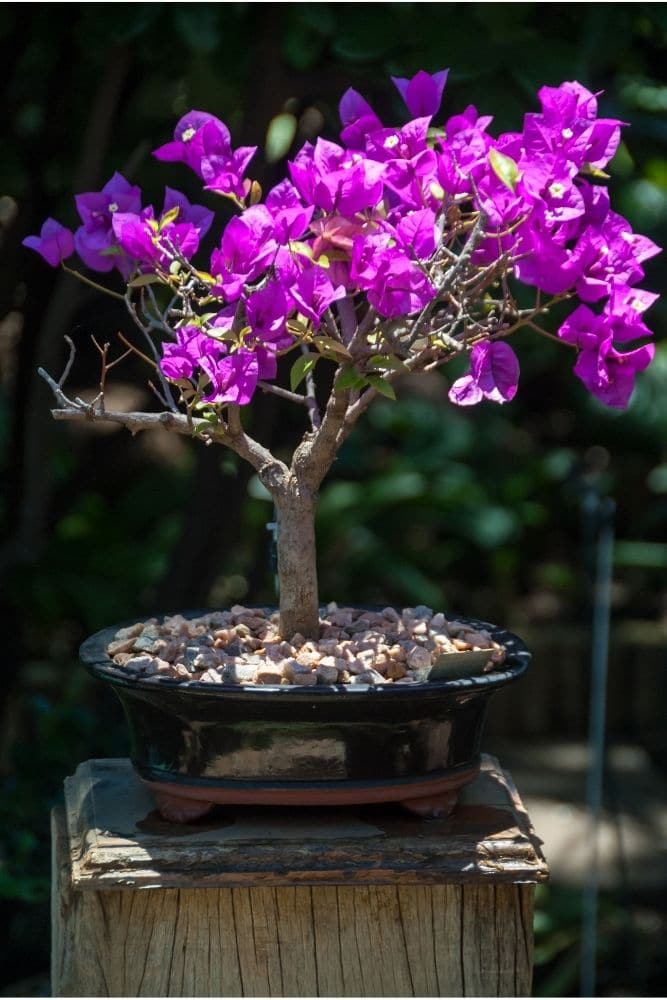
Bromeliad Bonsai Tree
These tropical plants make a unique, beautiful bonsai tree. Bromeliads are happiest when they are placed outdoors in full sunlight. You also don’t have to worry about watering too much, but their soil must be kept moist at all times. It’s best not to group them together either as they rely on air flowing through them to grow healthily.
Brush Cherry Bonsai Tree
Brush Cherry Bonsai Trees can be grown indoors and outdoors, but you must make sure that you give them plenty of water. Keep the soil moist and never let it dry out completely. In the spring, you’ll be treated to a display of small white flowers with red fruits, some of which are edible!
Cape Honeysuckle Bonsai Tree
The Cape Honeysuckle makes a wonderful bonsai tree, but it does require some special care that only experienced bonsai artists would be able to provide. Throughout summer, they will produce bright, eye-catching flowers that emit a beautiful scent.
Celtis Bonsai Tree
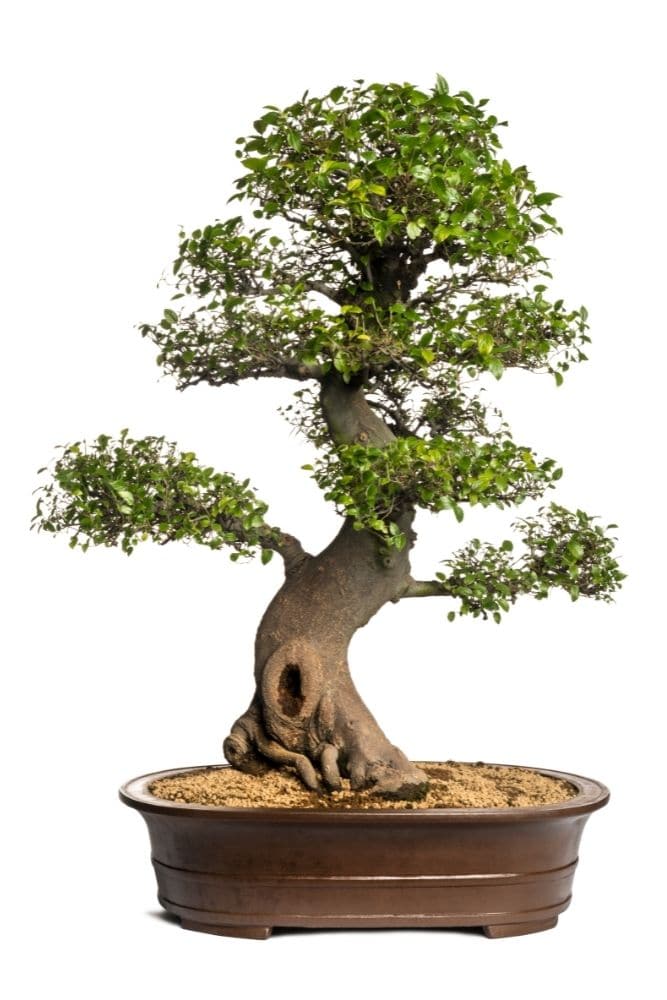
Citrus Bonsai Tree
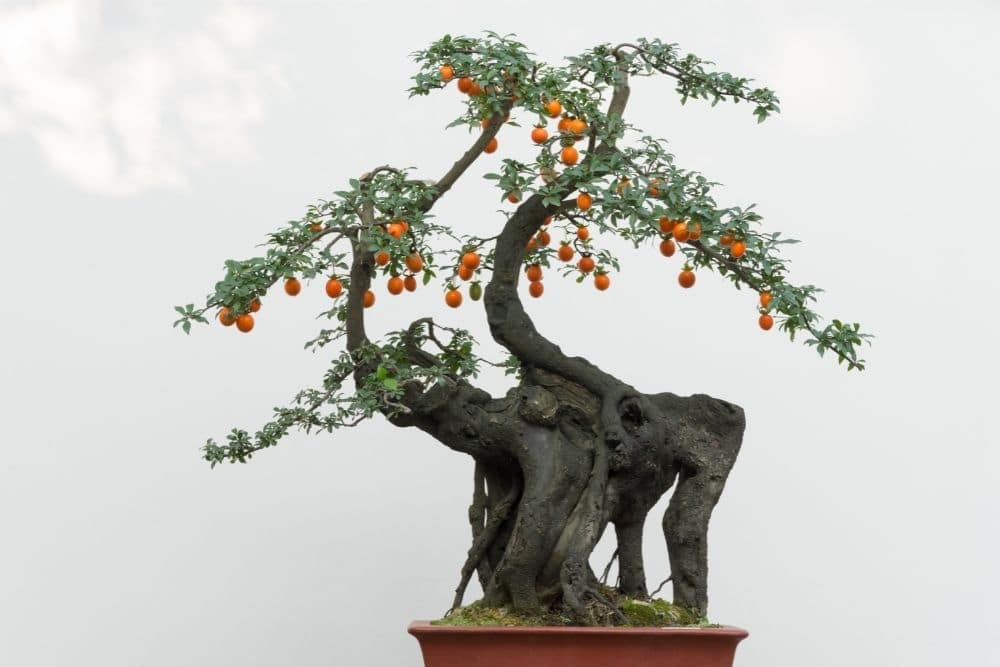
As you may have guessed, Citrus Bonsai Trees produce miniature lemons or oranges. These fruits are also edible and can be used in a variety of ways, and they follow on from a display of sweet-smelling white flowers. Keep in a sunny position, and keep well-watered at all times. This will help the fruits grow.
Cherry Blossom Bonsai Tree
There aren’t many bonsai trees that can compare with the Cherry Blossom (Prunus x yedoensis) in terms of beauty. The trunk is aged and architectural, and the display of pink blossoms is truly breathtaking. It’s also remarkably easy to grow! Place in a partially-shaded spot out of direct sunlight, and bring them indoors over winter.
Chinese Pepper Bonsai Tree
The Chinese Pepper Bonsai Tree also produces edible fruits, but you’ll need to be a fan of spice to enjoy them! These fiery peppers follow a display of white flowers in the spring and they are very easy to grow. Keep in full sun and water consistently, especially when the fruits start forming.
Crabapple Bonsai Tree
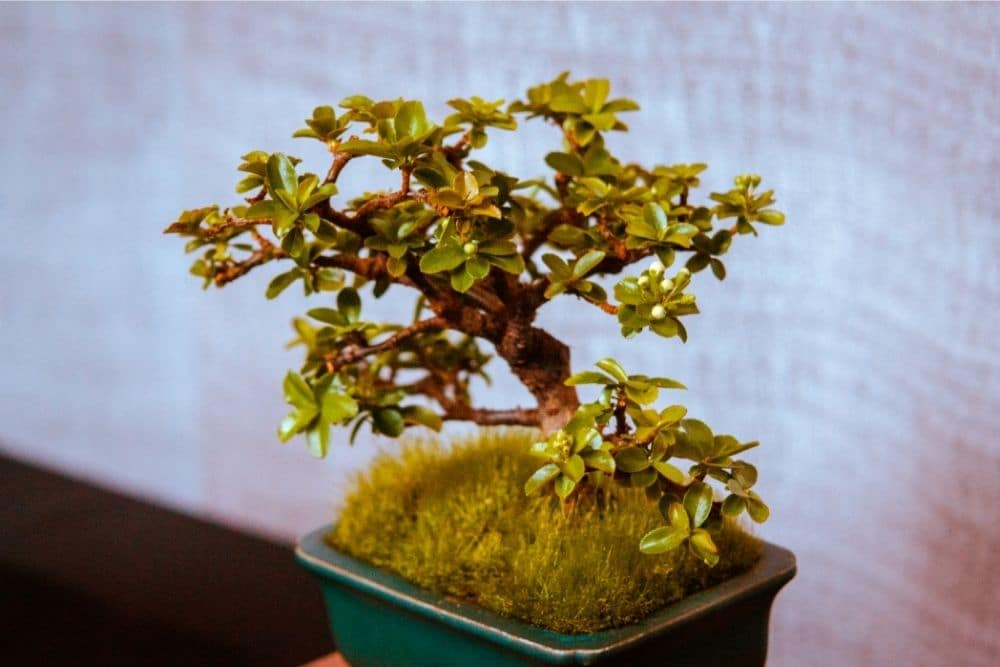
The Crabapple Bonsai Tree produces a mass of tiny fruits that can be eaten raw or made into jams and desserts. Keep the tree in a position with as much full sun as possible throughout the day and give it plenty of water.
Cotoneaster Bonsai Tree
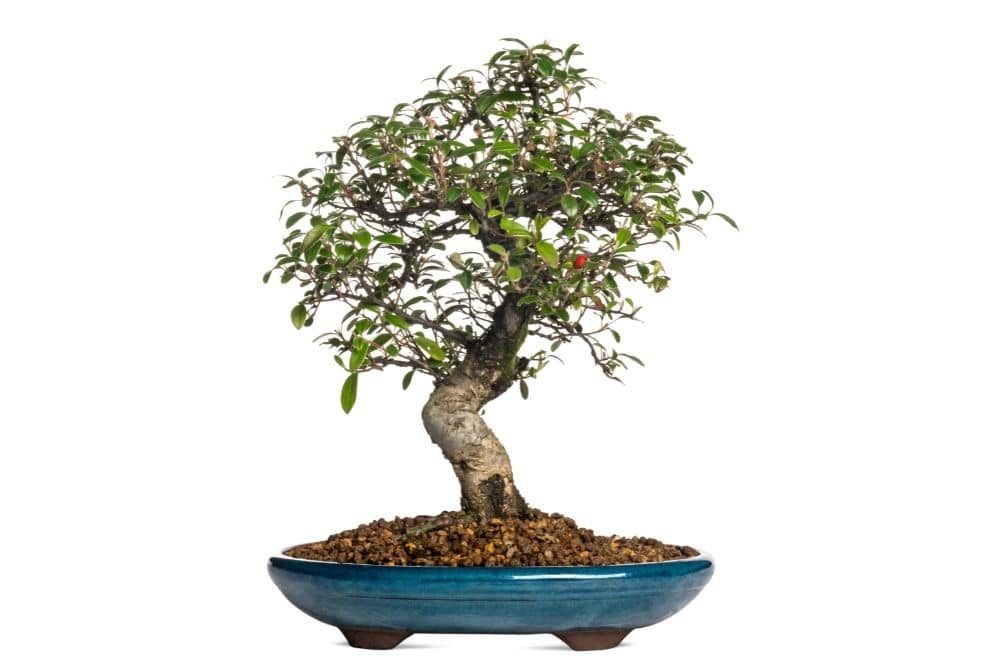
This type of bonsai tree thrives best when grown outdoors under full sun. They are also really low-maintenance and can go for quite a lot of time without needing to be watered. This makes them an excellent choice for a beginner or a busy person.
Crepe Myrtle Bonsai Tree
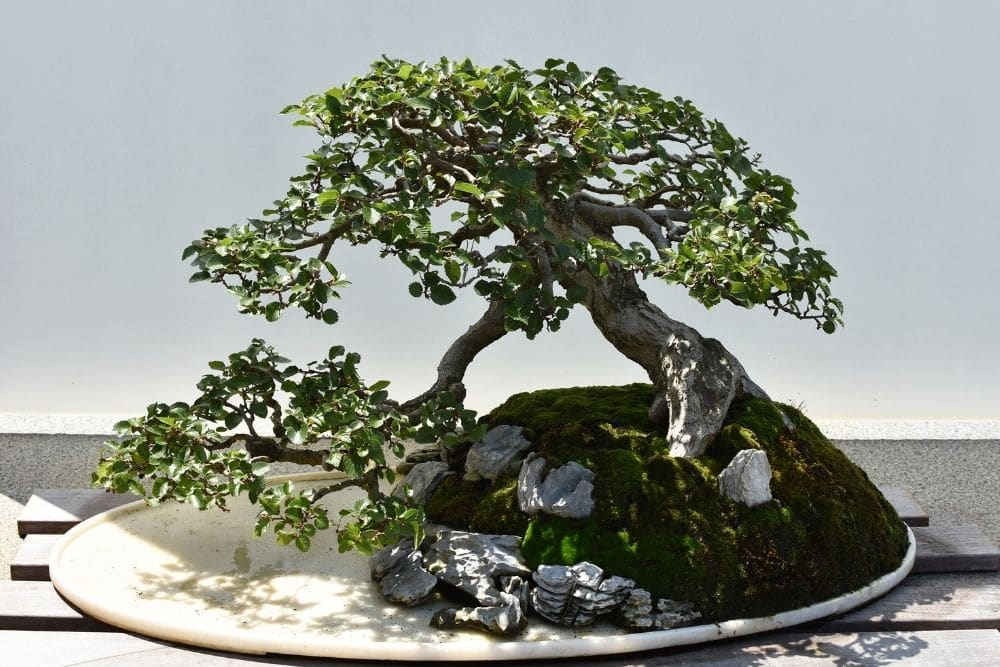
This is another low-maintenance tree that grows best when placed in as much full sunlight throughout the day as possible. In the spring, the Crepe Myrtle Bonsai Tree produces fragrant pink flowers that fill the air with the scent.
Dogwood Bonsai Tree
The Dogwood Bonsai Tree has a couple of unique features that make it a wonderful addition to any collection. The first of these is a large, white flower that emerges from the ends of the branches just as summer begins.
In the winter, it also has bright-red stems that shine out against everything else. It’s easy to grow, just place it in direct sunlight and allow air to circulate around it.
Dwarf Pomegranate Bonsai Tree
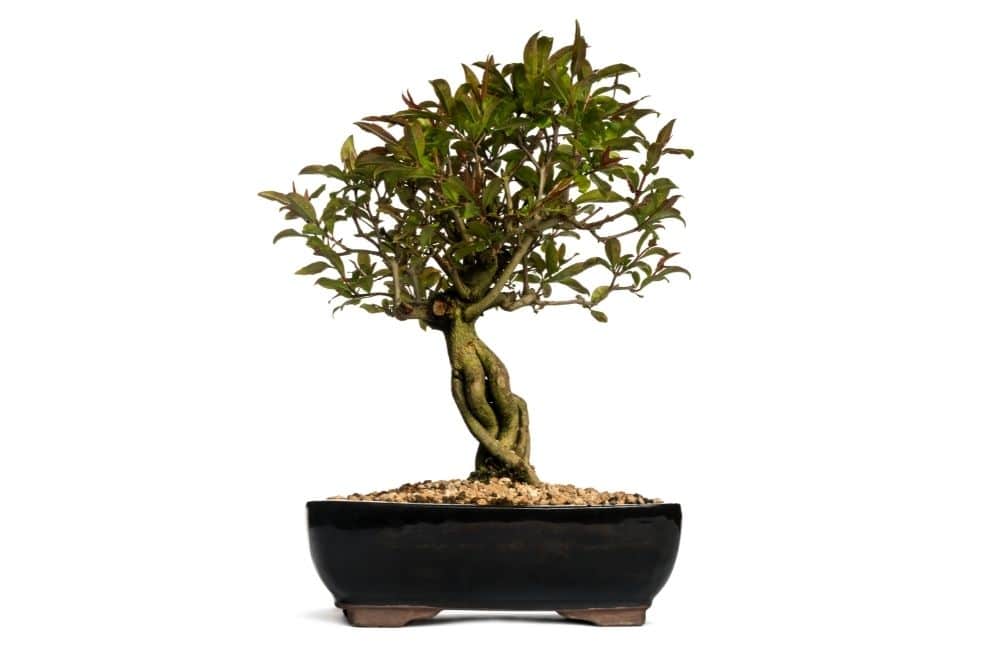
This is another great option to go for if you’d like to attract pollinators to your garden. The Dwarf Pomegranate Bonsai Tree produces big, red flowers that bees and butterflies will head straight towards. It needs a lot of water to grow well and it is best placed in full sun.
Firethorn Bonsai Tree
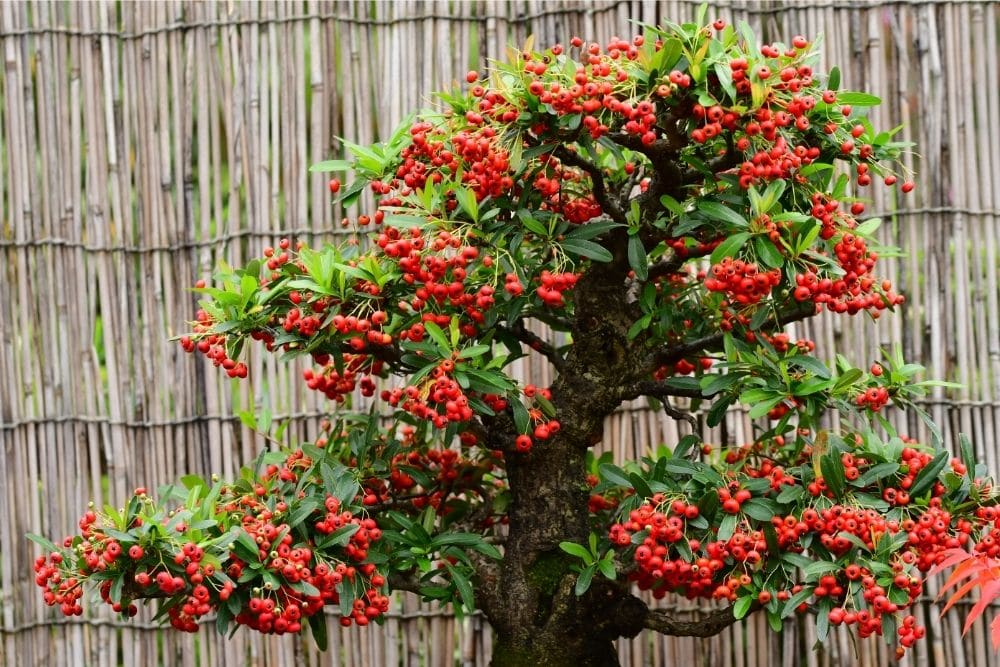
More commonly known as ‘Pyracantha’, the Firethorn Bonsai Tree has dark green foliage that acts as the perfect backdrop for its small red fruits. It thrives best in a sunny position and it needs regular watering, especially during the summer.
Fuchsia Bonsai Tree
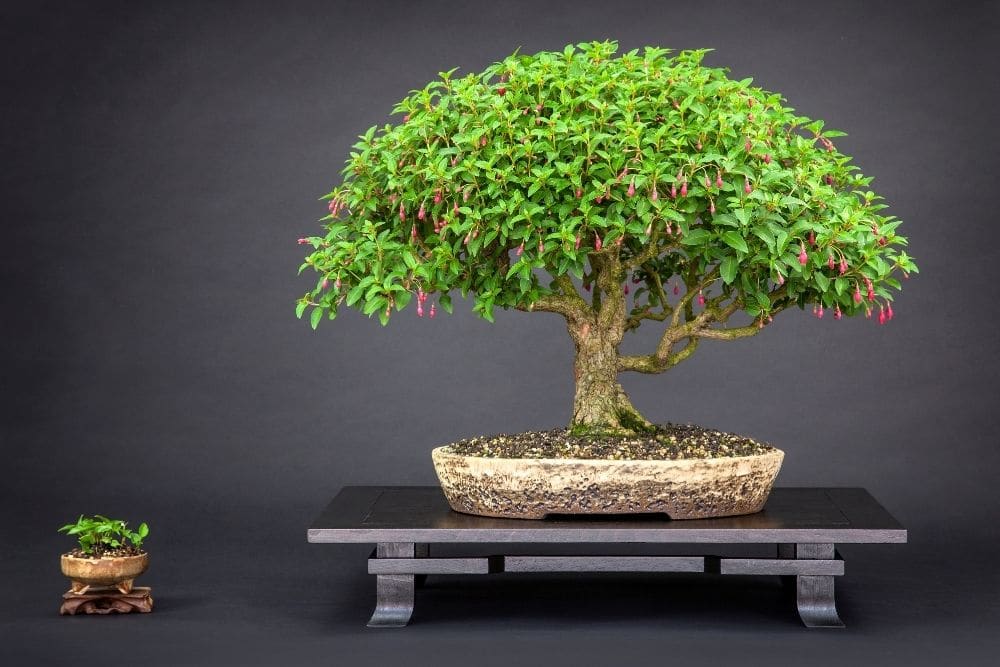
Fuchsia Bonsai Trees take a little more effort to grow. It needs as much sunlight as possible, regular watering, and regular pruning. This might seem like a lot of work, but the display of big, bright flowers you’ll be treated to makes it all worth it!
Fukien Tea Bonsai Tree
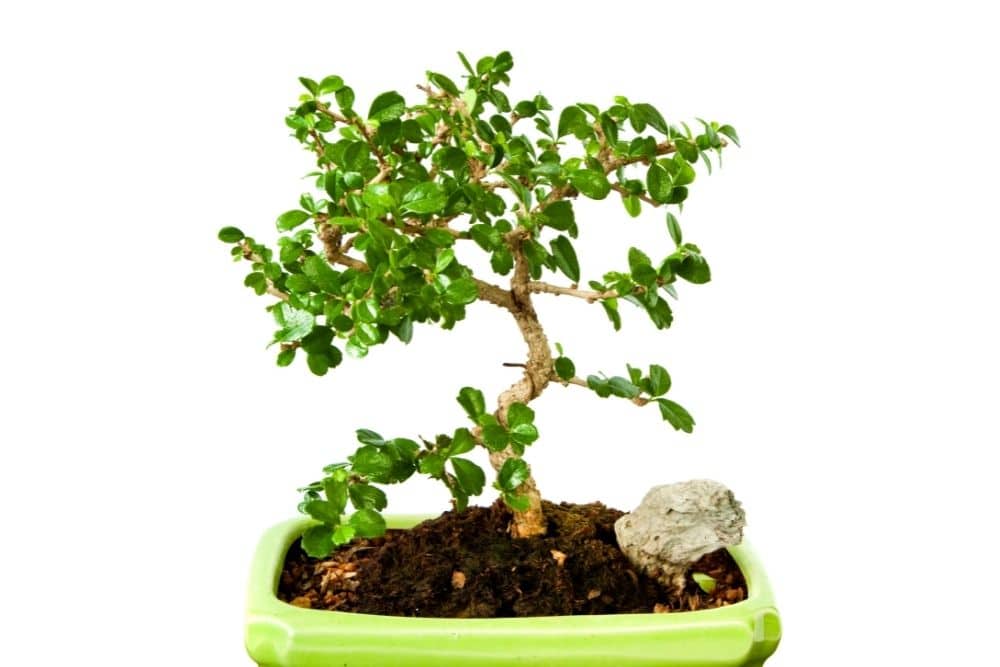
This is an excellent type of bonsai tree for beginners as it’s easy to grow and needs very little maintenance. Keep it in full sun and water regularly, and it will put on a display of small white flowers throughout the summer.
Grapevine Bonsai Tree
While you won’t be able to harvest enough to make a bottle of wine, the grapes produced by the Grapevine Bonsai Tree are perfectly edible. They are also surprisingly easy to grow. Simply place in a really sunny position outdoors and water regularly.
Hibiscus Bonsai Tree
The Hibiscus Bonsai Tree is a sun-worshipper that needs to be exposed to as much sunlight as possible throughout the day. It also needs to be watered daily, so it takes a little more maintenance than some other options. However, meet these requirements and it will produce huge flowers in shades of orange and red.
Magnolia Stellata Bonsai Tree
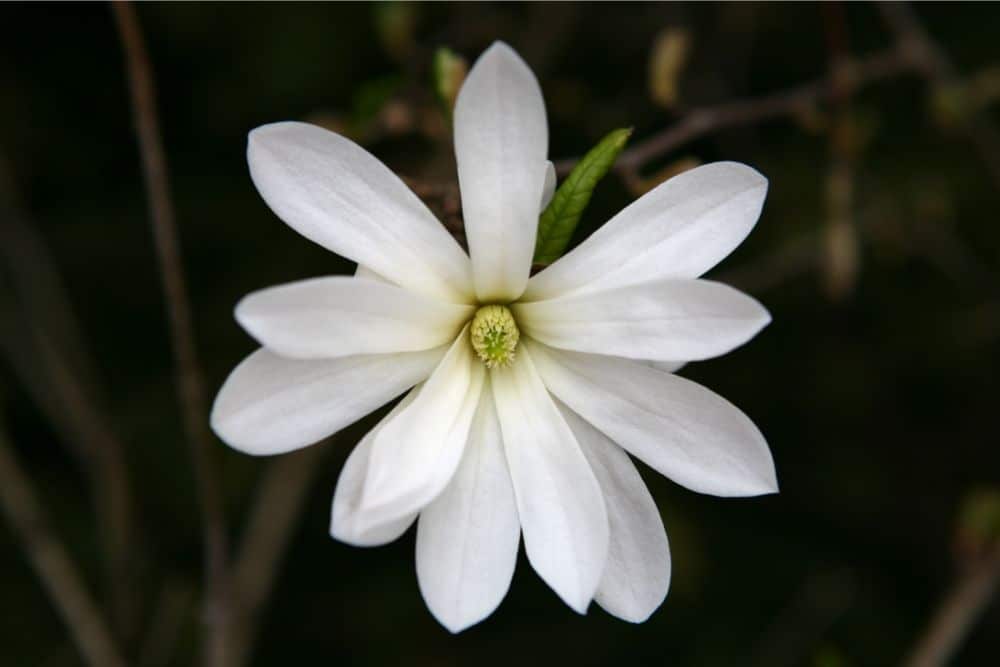
Another sun-worshipper, the Magnolia Stellata Bonsai Tree needs lots and lots of direct sunlight to thrive. It also needs lots of water, but care must be taken not to accidentally overwater. During the spring, it will produce big, beautiful flowers on bare stems.
Privet Bonsai Tree
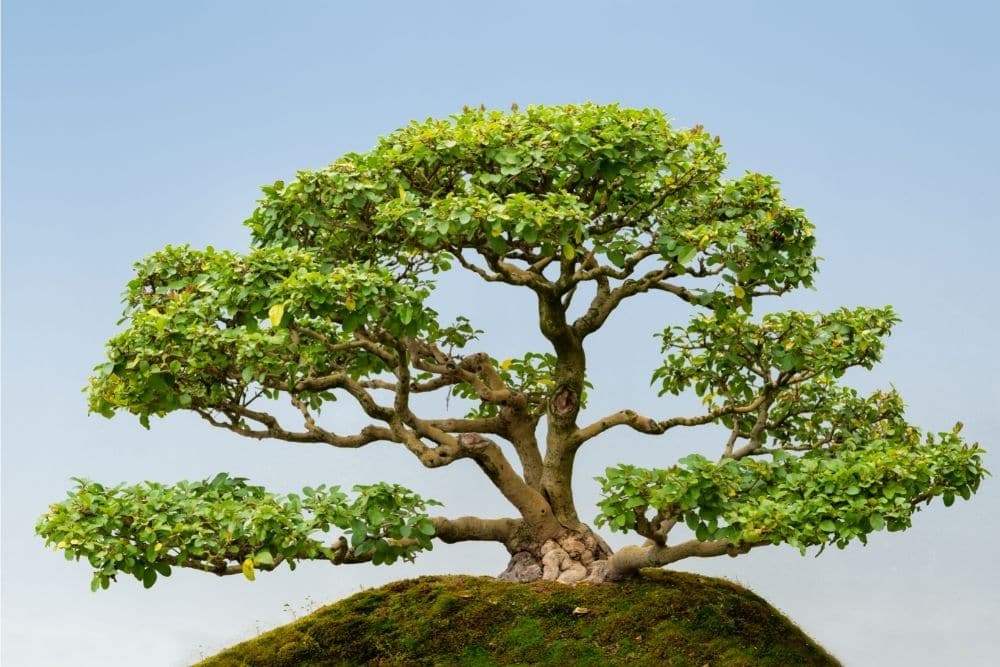
Privet is another plant that is used most commonly for hedging, but it also makes a wonderful bonsai tree. What’s more, it produces white and pink flowers! It’s easy to care for as well, simply keep it in a sunny position and give it plenty of water, particularly when the outdoor temperature is high.
Rosemary Bonsai Tree
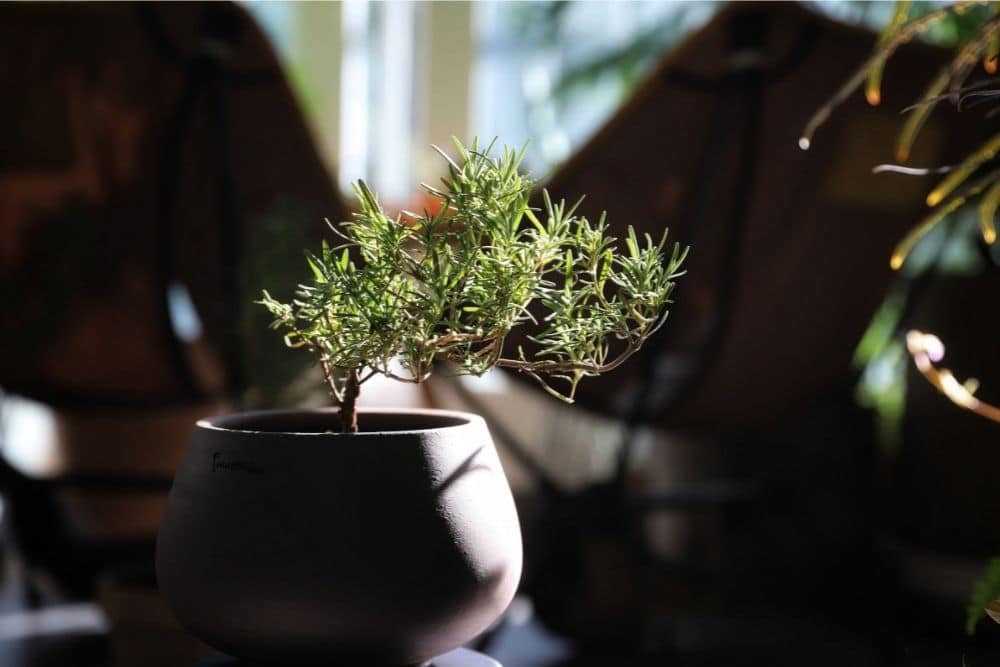
Did you know that you can grow Rosemary as a bonsai tree?! It’s really simple to do as well, and it’s perfect for beginners. Keep it in full sun and allow air to circulate around it at all times.
As a Mediterranean plant, it doesn’t need much water but care should be taken not to let the soil dry out completely. In the spring, it will produce white/blue flowers among its fragrant foliage.
Wisteria Bonsai Tree
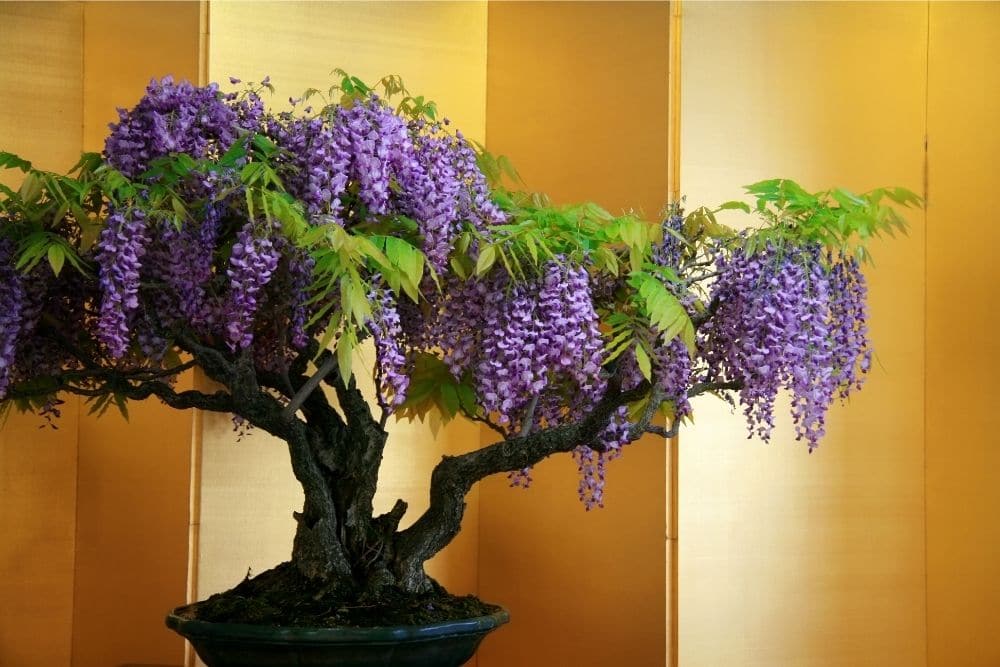
This is another architecturally stunning bonsai tree. Keep in full sunlight throughout the day and water frequently. During spring and summer, it will put on a display of purple flowers that hang in racemes beneath its delicate leaves.
Yew Bonsai Tree
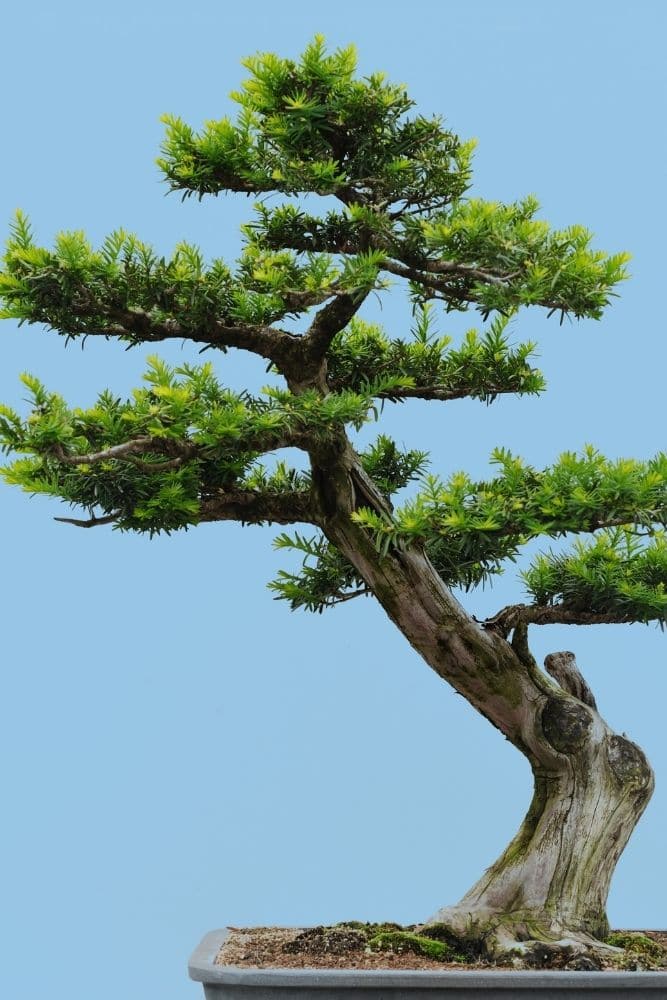
Artificial Bonsai Trees
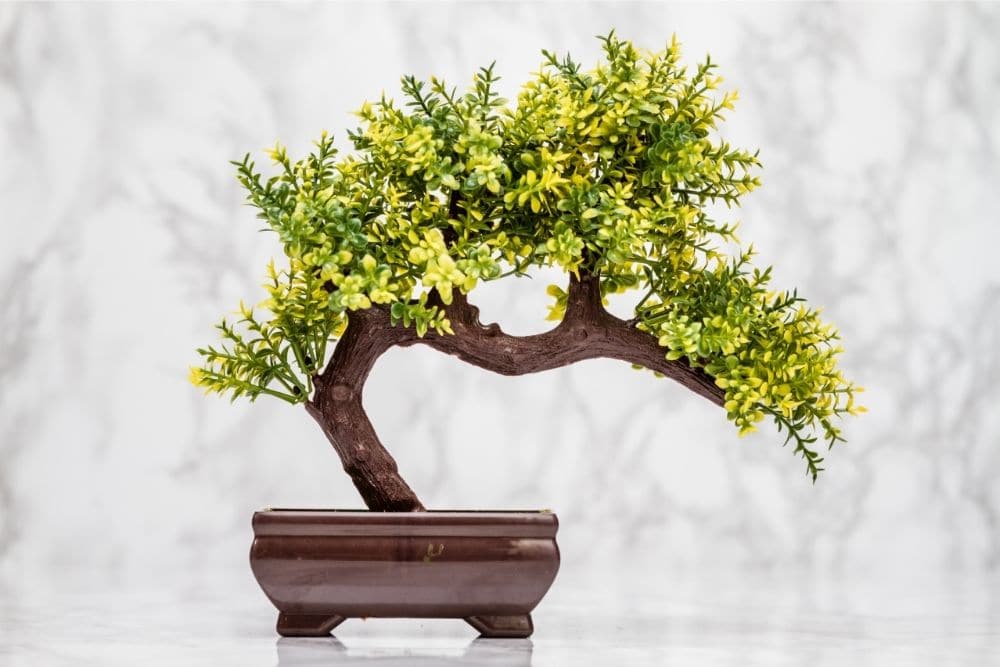
Finally, if you want a bonsai tree that is as low-maintenance as possible, you might want to think about getting an artificial bonsai tree. It won’t need watering, feeding, or pruning. It’ll simply look the same forever!
One thing to consider here is that you don’t get to practice the art of bonsai with an artificial bonsai tree. However, they are perfect if you want to enjoy the aesthetics of a bonsai tree, and they can be found mimicking loads of different types of the real thing.
Things to Consider Before Buying a Bonsai Tree
As you can see, there is a huge variety of bonsai trees you can grow. There is also a suitable choice for all growing conditions. However, before you start building your collection, there are a few things you need to consider.
First of all, you need to think about your current skill level. Are you brand new to the art of bonsai? If you are, then it’s best to go for a bonsai tree that is easier to maintain. This allows you to start learning how to care for it over time, rather than focusing on a bonsai that needs constant attention.
You also need to think about the climate you live in. If you live in an area that gets incredibly hot during the summer, you’re better off with a bonsai tree that can survive these conditions. Likewise, if the climate is cooler, you should get a bonsai tree that doesn’t need warmer conditions to thrive.
Finally, it’s a good idea to consider your budget before you purchase a bonsai tree. Despite their tiny size, some bonsai trees can be remarkably expensive! If you’ve been practicing the art of bonsai for a while, an expensive tree can be a good investment and it’ll certainly bring your hours of joy.
However, if you’re brand new to bonsai trees, you’re better off getting one at the lower end of the price range. This will give you the opportunity to practice the art without having to worry about killing it and losing all of your money!
Conclusion
There you have it – 64 popular types of bonsai trees you can grow both indoors and outdoors. All you have to do now is find the perfect trees for the growing conditions you can provide and that fit your budget, and you’ll soon have a fantastic collection of bonsai trees to boast about!
